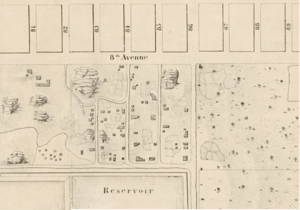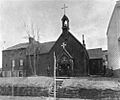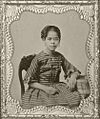Seneca Village facts for kids
Seneca Village was a special community in New York City during the 1800s. It was located in what is now Central Park in Manhattan. Most of the people living there were African Americans who owned their own land. This was very important at a time when many Black people did not have such rights.
The village started in 1825, created by free Black Americans. It was the first community of its kind in New York City. At its busiest, about 225 people lived there. They had three churches, two schools, and three cemeteries. Later, Irish and German immigrants also moved to Seneca Village. The community lasted until 1857. At that time, the city used a law called eminent domain to take the land. All the villagers were forced to leave, and their homes were torn down to build Central Park.
For a long time, people forgot about Seneca Village. But in 1992, a book brought its story back to life. Since then, groups have worked to teach people about the village. They have put up historical signs and done archaeological digs to find old items. In 2019, temporary signs were placed in Central Park to show where the village's churches, homes, and gardens once stood.
Contents
What's in a Name? The Story Behind "Seneca Village"
No one is completely sure how Seneca Village got its name. Only one person, Thomas McClure Peters, who was a church leader nearby, wrote about it. But there are a few ideas:
- A Roman Philosopher: Some think the name came from a Roman philosopher named Seneca the Younger. His writings, especially one about treating enslaved people well, were popular with African American activists.
- Native American Influence: It might have been named after the Seneca nation of Native Americans. Even though their main lands were far away, records show that Native Americans, Black people, and white people lived together in the area.
- West African Roots: Another idea is that "Seneca" came from Senegal, a country in West Africa. Some villagers might have come from there.
- A Secret Code: The name could also have been a secret code word used on the Underground Railroad. This was a network that helped enslaved people escape to freedom.
Life in Seneca Village
How Seneca Village Grew
Seneca Village was built on land that had natural features we can still see today. These include Summit Rock, which was then called Goat Hill. It is the highest point in Central Park. There was also Tanner's Spring, which likely gave the village fresh water. The main street was called "Spring Street."
Before Black families moved in, a white farmer owned the land. In 1825, he started selling smaller parts of his property. On September 27, 1825, a 25-year-old Black man named Andrew Williams bought three lots. He worked as a boot cleaner and later as a cart driver. On the same day, Epiphany Davis, a clerk for a feed store, bought twelve lots. Both men were part of a group that helped Black members financially. A church group also bought land. By 1832, many lots were owned by African Americans.
More Black Americans moved to Seneca Village after slavery was made illegal in New York in 1827. In the 1830s, people from a nearby area called York Hill had to move. This was because a large water reservoir was being built. Many of them came to Seneca Village. The village also offered a safe place during riots against those who wanted to end slavery in 1834.
Later, during the Great Famine in Ireland, many Irish immigrants came to New York. Some of them settled in Seneca Village. This made the village grow by 30 percent. Both Black Americans and Irish immigrants faced unfair treatment in the city. But in Seneca Village, they lived close to each other. By 1855, about one-third of the village's people were Irish.
By 1855, Seneca Village had 52 houses. Most were one, two, or three stories tall and made of wood. Digs have found strong stone foundations, showing they were well-built. Many Black residents owned their homes. This was much higher than the rate of home ownership in the rest of New York City at the time. Owning land gave them more stability and a chance to vote.
Who Lived in Seneca Village?
In 1855, about 225 people lived in Seneca Village. Most had lived there for many years, which gave the community a strong, lasting feeling. At this time, most of New York City's population lived far to the south. The area where Seneca Village was located was more like the countryside.
In New York, Black men could vote only if they owned property worth at least $250. Owning land in Seneca Village helped Black men gain political power. In 1845, only about 100 Black New Yorkers could vote, and 10 of them lived in Seneca Village.
Many residents worked in jobs like construction or food service. Some were poor, but others were middle-class. Many Black women worked as house servants. People in the village had gardens to grow their own food. They also used natural resources like fish from the Hudson River and wood from nearby forests. Some residents even had barns and raised animals.
Important Community Places
Seneca Village had a strong community with several important places. It had three churches, two schools, and three cemeteries. By 1855, about two-thirds of the people regularly went to church. Two churches, First African Methodist Episcopal Zion Church and African Union Church, were for Black people. All Angels' Church had both Black and white members.
The AME Zion Church bought land in Seneca Village in 1827 for burials. In 1853, they built a church building there. The church also had a school in its basement.
The African Union Church bought land in 1837. It had about 50 members. Next to this church was a branch of the African Free School, which later became Colored School No. 3. This public school taught 75 students.
All Angels' Church started in 1846. It was connected to a wealthy white church called St. Michael's. All Angels' Church had a mix of Black and German Protestant members. It also had a cemetery that was used a lot during a cholera outbreak in 1849. When Seneca Village was destroyed, All Angels' Church was physically moved a few blocks away.
Other Settlements Nearby
Seneca Village was the biggest community in what is now Central Park. But there were smaller settlements around it, mostly with Irish and German immigrants.
- Pigtown: This was a small area with about 14 Irish families. It was called Pigtown because residents kept pigs and goats.
- Other Irish and German Areas: Many other Irish and German families lived in different parts of the future park. They often had their own gardens.
- Industrial Sites: Near Seneca Village, there were places that processed animal bones. People from the village and nearby settlements worked there.
- Harsenville: To the southwest of Seneca Village was Harsenville, which is now part of the Upper West Side.
- Northern Park Settlements: In the northern part of the park, there was a section of the old Boston Post Road. This area also had McGowan's Pass, a historic spot from the American Revolutionary War, and Blockhouse No. 1, a fort built during the War of 1812.
The End of Seneca Village
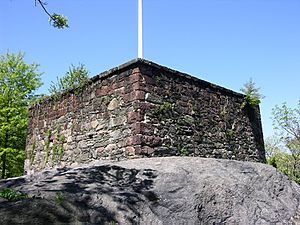
Planning Central Park
By the 1840s, rich people in New York City wanted a large public park. Two important people who supported this idea were William Cullen Bryant, a newspaper editor, and Andrew Jackson Downing, a landscape designer. They looked at different places for the park.
One idea was to use land called Jones's Wood. But wealthy families who owned that land did not want to sell it. So, the city looked at another area, which became "Central Park." This large area was between 59th and 106th Streets. In 1853, a law was passed to buy this land for the park.
Before the land was bought, some people and newspapers started to talk badly about Seneca Village. They called it a "shantytown" and said its residents were "squatters" or "vagabonds." They also used mean words to describe the Irish and Black residents. They even accused villagers of stealing and running illegal bars. While some residents did not own land, most had agreements with landlords. Only a few were truly squatters.
Forced to Leave
In 1853, the city started to figure out how much the properties in Central Park were worth. By 1855, they had finished their evaluations. All landowners and people with long-term leases received money for their property. However, only about 20% of the people living in Seneca Village actually owned land. Landowners were offered an average of $700 for their property. For example, Andrew Williams received $2,335 for his house and three lots. This was much more than the $125 he paid in 1825.
The city began to clear the land quickly. They started making residents pay rent and enforcing old rules. For two years, the people of Seneca Village fought to keep their land. They protested and filed lawsuits. But in 1857, the city officially took all the private property in Seneca Village. By October 1, 1857, all the people living on the land for Central Park had been removed. A newspaper at the time said the village would not be forgotten because there were "many a brilliant and stirring fight."
All the villagers were forced out by 1857, and all the buildings were torn down. Only All Angels' Church survived by being moved a few blocks away. We don't have many records of where the villagers went after they were forced to leave. The community was completely destroyed.
In later years, some signs of Seneca Village were found. In 1871, workers found two coffins with Black people inside near 85th Street. Fifty years later, a gardener found another burial plot at the same spot.
Finding Seneca Village Again
For over 100 years after it was destroyed, Seneca Village was mostly forgotten. It was brought back to public attention in the late 1970s and then more widely after a book was published in 1992. The story of Seneca Village has been used to show how communities can be unfairly removed, especially those of minority groups.
Remembering the Village
The Seneca Village Project started in 1998. It is a group that works to teach people about Seneca Village. They want everyone to know how important it was as a free, middle-class Black community in the 1800s. The project offers educational programs for kids, teachers, and the public.
In 2001, a special sign was put up to remember where Seneca Village once stood. It is near the Mariners Playground in Central Park.
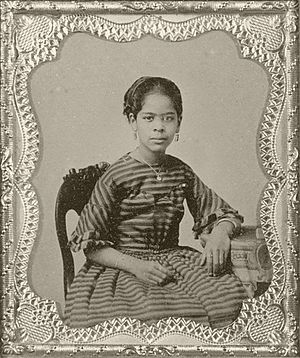
In 2019, the city announced plans for a statue to honor the Lyons family. They were property owners in the village, including Albro Lyons Sr. and his daughter Maritcha Remond Lyons. The statue will be in the northern part of Central Park.
Also in 2019, an outdoor exhibit called "Discover Seneca Village" opened. It has temporary signs that mark where the village's churches, houses, and gardens were.
Digging Up History: Archaeology
After a 1997 exhibit about Seneca Village, researchers decided to see if any parts of the village were still buried. They worked with local historians and churches. In 2000, they started using special tests to find traces of the village. They used ground-penetrating radar in 2005, which helped them find signs of Seneca Village underground.
After getting permission, they started digging in 2004, 2005, and 2011. The 2011 dig found the foundation walls and cellar of William Godfrey Wilson's home. He was a church worker for All Angels' Church. They also found items in the backyard of two other villagers. Archaeologists found over 250 bags of artifacts, including a toothbrush handle made of bone and a child's shoe sole made of leather. In 2020, an online exhibit called Seneca Village Unearthed showed about 300 items from the 2011 dig.
Seneca Village in Art and Culture
The story of Seneca Village has inspired many artists.
- Keith Josef Adkins's play The People Before the Park was first performed in 2015.
- Marilyn Nelson's poetry book My Seneca Village was published in the same year.
- Before Yesterday We Could Fly, an exhibit at the Metropolitan Museum of Art, opened in 2021. It shows a room that looks like a Seneca Village home. It also imagines how the villagers' descendants might live today if the village had not been destroyed. This part is inspired by Afrofuturism, an art style that looks at possible futures for people of African descent.
- The animated TV show Central Park (2020) mentions Seneca Village in its first episode. It calls it a "dark chapter" in the park's history.
Images for kids
-
Blockhouse No. 1, a structure that existed before Central Park.
-
Maritcha Remond Lyons came from a family who owned property in Seneca Village.
See also
 In Spanish: Seneca Village para niños
In Spanish: Seneca Village para niños



